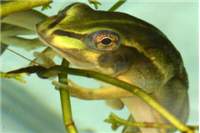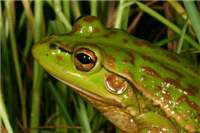Family
Hylidae
Genus
Litoria
Species
raniformis
Threats/Control Methods - Regional
There are numerous broad-scale threatening processes including loss of habitat, UV-B, exotic predators and the leaching of herbicides/pesticides. However, the loss of this species from the Southern Tablelands is thought to be the result of infection by the Chytrid fungus, potentially coupled with predation by introduced fish species including Gambusia holbrooki.
Local/Urban Actions
The Department of Environment and Heritage has an action plan in place for the recovery of the species, however as little is know for the reasons of its widespread decline, little can be done until there is a deeper understanding of the processing threatening the species, for more information see http://www.deh.gov.au/biodiversity/threatened/action/frogs/14.html.
You can also help by getting involved in Frogwatch. Frogwatch is an annual program run to monitor the presence and abundance of frogs within the ACT region. By monitoring frog populations we can determine the success of action plans and also get an early warning of declines in frog populations. The Frogwatch program provides training for community volunteers each October, with monitoring then being undertaken by volunteers over a two week period.
For more information on Frogwatch contact:The ACT Frogwatch Coordinator, Ginninderra Catchment Group; Ph (02) 6278 3309 or email: [email protected]
Distinguishing Features
Adults range from 5.5-10cm in length. Litoria raniformis is characterised by smooth skin covered in green and gold blotches, with the sides of the thighs being a bright blue or purple colour. A thin black stripe extends from the snout down to the groin with a pale cream stripe running parallel from behind the eye. The call of the species is very similar to that of L.aurea sounding somewhat like a motorcycle changing gears, described as a ©wrrraaaaagh wrrraaaaagh wrrrkk, wrrkkk wrrkk©. Tadpoles are translucent yellow with emerald green pigments found along the spine and over the brain.
Common name/s
Southern Bell Frog, Warty-backed Frog, Green or Warty Swamp Frog.
Similar Species
Visually and aurally this frog is very similar to the closely related Litoria aurea (Green and Gold Bell Frog) but the two can be distinguished as L. aurea has smooth skin on its back, while Litoria raniformis has rough warty skin. Subtle differences in the call also distinguish the two species - try listening for the differences by flicking between the two profiles.
Distribution
Extends throughout much of southern NSW, across most of Victoria and the northern half of Tasmania to the south-eastern corner of South Australia.
Country of Origin
Australia
Survey Techniques
The most common technique for monitoring frog populations is based on call identification, with each frog species having a unique call. Frogs should not be handled without the use of sterile gloves, as their skin is very sensitive to chemicals, including soap and sunscreen. For more information see Local Actions below.
Conservation (Pet/Pest) Status - National
Vulnerable. (EPBC Act) Population size is thought to have declined over the last 50 years.
Conservation (Pet/Pest) Status - Regional
Extinct. Although once present within the Southern Tablelands the population is thought to have completely disappeared from this region sometime in the 1980©s. The populations in Victoria, SA and Tasmania have all experienced a decline.
LSCCES Population
Extinct. The species has not been detected within the ACT since the 1980©s.
Associated Vegetation Community
Swamps, lakes, lagoons, ponds and dams, especially areas with emergent vegetation such as bulrushes, (Typha sp).
Limiting Resources
Requires permanent water bodies for both habitation and breeding.
Breeding
Calls and breeds from August through to April. Eggs are found in a floaty jelly raft.
Behaviour
Like L. aurea this species is known for its unusual behaviour of basking in the sun (seldom where predatory birds are present). Males will often call after rain from spring-autumn, while floating on water debris.
Functional Group
Insectivorous, carnivorous, cannibalistic
Food Species
Like Litoria aurea this species has been known to eat other frogs. Other food species may include small lizards and invertebrates such as moths or beetles.
Predators
May include native birds, such as the White-Faced Heron (Egretta novaehollandiae) and Intermediate Egret, and fish, including the introduced Carp, Goldfish, Gambusia and Trout. Introduced species such as Cats (Felis catus) and Foxes may also predate on frogs.
Interesting Fact
The unusual behaviour of sunbaking by both L. raniformis and L. aurea , combined with increasing levels of UV radiation is thought to play a role in their recent decline.
References - (reader suitability of references, P=Primary teachers, S=Secondary students, T=Tertiary students and researchers)
Books:
Barker, J., Grigg,G., Tyler, M. (1995). A Field Guide to Australian Frogs. Surry Beatty & Sons. NSW, Australia. S, TLintermans,M. & Osborne, W. (2002). Wet & Wild: A Field Guide to the Freshwater Animals of the Southern Tablelands and High Country of the ACT and NSW. Environment ACT. Canberra, Australia. S, TRobinson, M. (1993). A Field Guide to Frogs of Australia. Australian Museum/Reed books. NSW, Australia. S, TTurner, J. (2004). Frogs of Australia. Pensoft. Bulgaria. P, STyler, J. (1994). Australian Frogs: A Natural History. Reed New Holland. Australia. S, TSwan, G.(2001). Green Guide: Frogs of Australia. New Holland Publishers. Sydney, Australia. P, S
Online Publications:
Amphibian Research Centre. (2005). Available Online: http://frogs.org.au/frogs/species/Litoria/raniformis/ S, TAustralian Frogs Database.(2005). Available Online: http://frogsaustralia.net.au/frogs/display.cfm?frog_id=180 S, TDepartment of Environment and Heritage, (2004). Chytridiomycosis Factsheet http://www.deh.gov.au/biodiversity/invasive/publications/c-disease/ S, TEnvironment ACT. (2004). Summary of results. Available online: http://www.environment.act.gov.au/Files/frogwatchoctober2004summary.pdf P, S, TZoological Parks and Gardens Board. Frog Pond Checklist. Available Online: http://www.zoo.org.au/education/factsheets/amp-frog_pond_checklist.pdf P, S, TSpeare, R et al (1998). HOW TO REDUCE THE RISKS OF YOU TRANSMITTING AN INFECTIOUS AGENT BETWEEN FROGS AND BETWEEN SITES. Available Online: http://www.jcu.edu.au/school/phtm/PHTM/frogs/prevent.htm S, TDepartment of Environment and Heritage. (2004.). Species Profile and Threats Database: Litoris reniformis. Available online: http://www.deh.gov.au/cgi-bin/sprat/public/publicspecies.pl?taxon_id=1828 S, TZoological Parks Board N>S>W. (2005.). ASX Frog Focus. Available online: http://www.asxfrogfocus.com/ P, S (School activity program)
Researcher: Pippa Jaminon



 Top
Top Top
Top